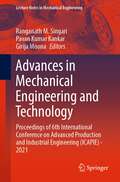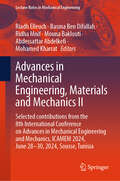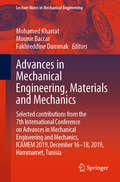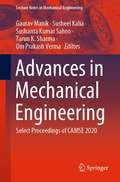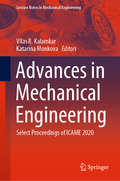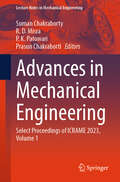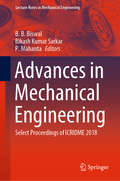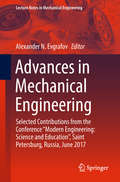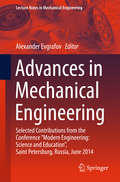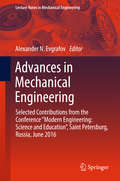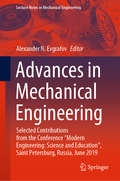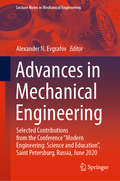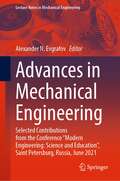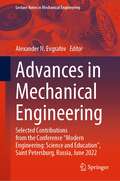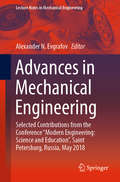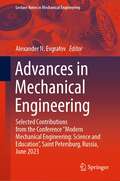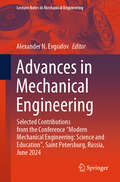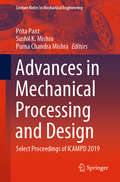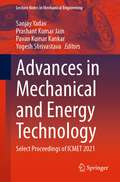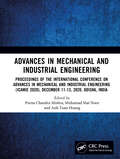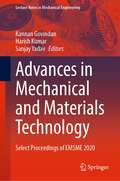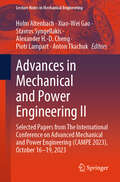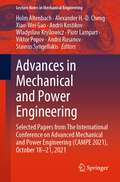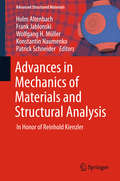- Table View
- List View
Advances in Mechanical Engineering and Technology: Proceedings of 6th International Conference on Advanced Production and Industrial Engineering (ICAPIE) - 2021 (Lecture Notes in Mechanical Engineering)
by Pavan Kumar Kankar Ranganath M. Singari Girija MoonaThis book presents the select proceedings of the International Conference on Advanced Production and Industrial Engineering (ICAPIE) - 2021 held at Delhi Technological University, Delhi, during June 18–19, 2021. The book covers the recent advances and challenges in the area of production and industrial engineering. Various topics covered include artificial intelligence and expert systems, CAD/CAM Integration Technology, CAD/CAM, automation and robotics, computer-aided geometric design and simulation, construction machinery and equipment, design tools, cutting tool material and coatings, dynamic mechanical analysis, optimization and control, energy machinery and equipment, flexible manufacturing technology and system, fluid dynamics, bio-fuels, fuel cells, high-speed/precision machining, laser processing technology, logistics and supply chain management, machinability of materials, composite materials, material engineering, mechanical dynamics and its applications, mechanical power engineering, mechanical transmission theory and applications, non-traditional machining processes, operations management, precision manufacturing and measurement, precision manufacturing and measurement, reverse engineering and structural strength and robustness. This book is useful for various researcher mainly mechanical and allied engineering discipline.
Advances in Mechanical Engineering, Materials and Mechanics II: Selected contributions from the 8th International Conference on Advances in Mechanical Engineering and Mechanics, ICAMEM 2024, June 28-30, 2024, Sousse, Tunisia (Lecture Notes in Mechanical Engineering)
by Mohamed Kharrat Riadh Elleuch Basma Ben Difallah Ridha Mnif Mouna Baklouti Abdessattar AbdelkefiThis book reports on cutting-edge research in the broad fields of mechanical engineering and mechanics. It describes innovative applications and research findings in design and manufacturing, applied and fluid mechanics, dynamics and control, thermal science, and materials. It also highlights several relevant advances in industrial applications. All papers were carefully selected from contributions presented at the International Conference on Advances in Mechanical Engineering and Mechanics, ICAMEM 2024, held on June 28-30, 2024, in Sousse, Tunisia, and organized by the Laboratory of Electromechanical Systems (LASEM) at the National School of Engineers of Sfax (ENIS) and the Tunisian Scientific Society (TSS), in collaboration with a great number of national and international research institutions and laboratories.
Advances in Mechanical Engineering, Materials and Mechanics: Selected contributions from the 7th International Conference on Advances in Mechanical Engineering and Mechanics, ICAMEM 2019, December 16-18, 2019, Hammamet, Tunisia (Lecture Notes in Mechanical Engineering)
by Mohamed Kharrat Mounir Baccar Fakhreddine DammakThis book reports on cutting-edge research in the broad fields of mechanical engineering and mechanics. It describes innovative applications and research findings in applied and fluid mechanics, design and manufacturing, thermal science and materials. A number of industrially relevant recent advances are also highlighted. All papers were carefully selected from contributions presented at the International Conference on Advances in Mechanical Engineering and Mechanics, ICAMEM2019, held on December 16–18, 2019, in Hammamet, Tunisia, and organized by the Laboratory of Electromechanical Systems (LASEM) at the National School of Engineers of Sfax (ENIS) and the Tunisian Scientific Society (TSS), in collaboration with a number of higher education and research institutions in and outside Tunisia.
Advances in Mechanical Engineering: Select Proceedings of CAMSE 2020 (Lecture Notes in Mechanical Engineering)
by Susheel Kalia Tarun K. Sharma Om Prakash Verma Gaurav Manik Sushanta Kumar SahooThis book presents the select proceedings of Congress on Advances in Materials Science and Engineering (CAMSE 2020). It focuses on the state-of-the-art research, development, and commercial prospective of recent advances in mechanical engineering. The book covers various synthesis and fabrication routes of functional and smart materials for applications in mechanical engineering, manufacturing, physics, chemical and biological sciences, metrology, optimization and artificial intelligence among others. This book will be a useful resource for researchers, academicians as well as professionals interested in the highly interdisciplinary field of materials science and mechanical engineering.
Advances in Mechanical Engineering: Select Proceedings of ICAME 2020 (Lecture Notes in Mechanical Engineering)
by Vilas R. Kalamkar Katarina MonkovaThis book presents select peer-reviewed proceedings of the International Conference on Advances in Mechanical Engineering (ICAME 2020). The contents cover latest research in several areas such as advanced energy sources, automation, mechatronics and robotics, automobiles, biomedical engineering, CAD/CAM, CFD, advanced engineering materials, mechanical design, heat and mass transfer, manufacturing and production processes, tribology and wear, surface engineering, ergonomics and human factors, artificial intelligence, and supply chain management. The book brings together advancements happening in the different domains of mechanical engineering, and hence, this will be useful for students and researchers working in mechanical engineering.
Advances in Mechanical Engineering: Select Proceedings of ICRAME 2023, Volume 1 (Lecture Notes in Mechanical Engineering)
by Suman Chakraborty R. D. Misra P. K. Patowari Prasun ChakrabortiThis book presents select proceedings of the 4th International Conference on Recent Advancements in Mechanical Engineering (ICRAME 2023). Various topics covered in this book volume are intelligent manufacturing systems, tribology, nanomechanics, MEMS, solar thermal energy, design engineering, materials, conventional and non-conventional machining, etc. The book is useful for researchers and professionals working in the different areas if mechanical engineering.
Advances in Mechanical Engineering: Select Proceedings of ICRIDME 2018 (Lecture Notes in Mechanical Engineering)
by B. B. Biswal Bikash Kumar Sarkar P. MahantaThis book comprises select proceedings of the International Conference on Recent Innovations and Developments in Mechanical Engineering (IC-RIDME 2018). The book contains peer reviewed articles covering thematic areas such as fluid mechanics, renewable energy, materials and manufacturing, thermal engineering, vibration and acoustics, experimental aerodynamics, turbo machinery, and robotics and mechatronics. Algorithms and methodologies of real-time problems are described in this book. The contents of this book will be useful for both academics and industry professionals.
Advances in Mechanical Engineering: Selected Contributions From The Conference Modern Engineering: Science And Education , Saint Petersburg, Russia, June 2016 (Lecture Notes In Mechanical Engineering)
by Alexander N. EvgrafovThis book draws together the most interesting recent results to emerge in mechanical engineering in Russia, providing a fascinating overview of the state of the art in the field in that country which will be of interest to a wide readership. A broad range of topics and issues in modern engineering are discussed, including dynamics of machines, materials engineering, structural strength and tribological behavior, transport technologies, machinery quality and innovations. The book comprises selected papers presented at the 6th conference "Modern Engineering: Science and Education", held at the Saint Petersburg State Polytechnic University in June 2017 with the support of the Russian Engineering Union. The authors are experts in various fields of engineering, and all of the papers have been carefully reviewed. The book will be of interest to mechanical engineers, lecturers in engineering disciplines and engineering graduates.
Advances in Mechanical Engineering: Selected Contributions from the Conference “Modern Engineering: Science and Education”, Saint Petersburg, Russia, June 2014 (Lecture Notes in Mechanical Engineering)
by Alexander EvgrafovThis book draws together the most interesting recent results to emerge in mechanical engineering in Russia, providing a fascinating overview of the state of the art in the field in that country which will be of interest to a wide readership. A broad range of topics and issues in modern engineering are discussed, including dynamics of machines, materials engineering, structural strength and tribological behavior, transport technologies, machinery quality and innovations. The book comprises selected papers presented at the conference "Modern Engineering: Science and Education", held at the Saint Petersburg State Polytechnic University in 2013 with the support of the Russian Engineering Union. The authors are experts in various fields of engineering, and all of the papers have been carefully reviewed. The book will be of interest to mechanical engineers, lecturers in engineering disciplines and engineering graduates.
Advances in Mechanical Engineering: Selected Contributions from the Conference “Modern Engineering: Science and Education”, Saint Petersburg, Russia, June 2016 (Lecture Notes in Mechanical Engineering)
by Alexander N. EvgrafovThis book draws together the most interesting recent results to emerge in mechanical engineering in Russia, providing a fascinating overview of the state of the art in the field in that country which will be of interest to a wide readership. A broad range of topics and issues in modern engineering are discussed, including dynamics of machines, materials engineering, structural strength and tribological behavior, transport technologies, machinery quality and innovations. The book comprises selected papers presented at the conference "Modern Engineering: Science and Education", held at the Saint Petersburg State Polytechnic University in 2016 with the support of the Russian Engineering Union. The authors are experts in various fields of engineering, and all of the papers have been carefully reviewed. The book will be of interest to mechanical engineers, lecturers in engineering disciplines and engineering graduates.
Advances in Mechanical Engineering: Selected Contributions from the Conference “Modern Engineering: Science and Education”, Saint Petersburg, Russia, June 2019 (Lecture Notes in Mechanical Engineering)
by Alexander N. EvgrafovThis book draws together the most interesting recent results to emerge in mechanical engineering in Russia, providing a fascinating overview of the state of the art in the field in that country which will be of interest to a wide readership. A broad range of topics and issues in modern engineering are discussed, including dynamics of machines, materials engineering, structural strength and tribological behavior, transport technologies, machinery quality and innovations. The book comprises selected papers presented at the 8th conference "Modern Engineering: Science and Education", held at the Saint Petersburg State Polytechnic University in May 2019 with the support of the Russian Engineering Union. The authors are experts in various fields of engineering, and all of the papers have been carefully reviewed. The book will be of interest to mechanical engineers, lecturers in engineering disciplines and engineering graduates.
Advances in Mechanical Engineering: Selected Contributions from the Conference “Modern Engineering: Science and Education”, Saint Petersburg, Russia, June 2020 (Lecture Notes in Mechanical Engineering)
by Alexander N. EvgrafovThis book draws together the most interesting recent results to emerge in mechanical engineering in Russia, providing a fascinating overview of the state of the art in the field in that country which will be of interest to a wide readership. A broad range of topics and issues in modern engineering are discussed, including dynamics of machines, materials engineering, structural strength, transport technologies, machinery quality and innovations. The book comprises selected papers presented at the 9th conference "Modern Engineering: Science and Education", held at the Peter the Great Saint Petersburg Polytechnic University in June 2020 with the support of the Russian Engineering Union. The authors are experts in various fields of engineering, and all of the papers have been carefully reviewed. The book will be of interest to mechanical engineers, lecturers in engineering disciplines and engineering graduates.
Advances in Mechanical Engineering: Selected Contributions from the Conference “Modern Engineering: Science and Education”, Saint Petersburg, Russia, June 2021 (Lecture Notes in Mechanical Engineering)
by Alexander N. EvgrafovThis book draws together the most interesting recent results to emerge in mechanical engineering in Russia, providing a fascinating overview of the state of the art in the field in that country which will be of interest to a wide readership. A broad range of topics and issues in modern engineering is discussed, including dynamics of machines, materials engineering, structural strength and tribological behavior, transport technologies, machinery quality and innovations. The book comprises selected papers presented at the 10th conference "Modern Engineering: Science and Education", held at the Saint Petersburg State Polytechnic University in June 2021 with the support of the Russian Engineering Union. The authors are experts in various fields of engineering, and all of the papers have been carefully reviewed. The book will be of interest to mechanical engineers, lecturers in engineering disciplines and engineering graduates.
Advances in Mechanical Engineering: Selected Contributions from the Conference “Modern Engineering: Science and Education”, Saint Petersburg, Russia, June 2022 (Lecture Notes in Mechanical Engineering)
by Alexander N. EvgrafovThis book draws together the most interesting recent results to emerge in mechanical engineering in Russia, providing a fascinating overview of the state of the art in the field in that country which will be of interest to a wide readership. A broad range of topics and issues in modern engineering is discussed, including dynamics of machines, materials engineering, structural strength and tribological behavior, transport technologies, machinery quality and innovations. The book comprises selected papers presented at the 11th conference “Modern Engineering: Science and Education”, held at the Saint Petersburg State Polytechnic University in June 2022 with the support of the Russian Engineering Union. The authors are experts in various fields of engineering, and all of the papers have been carefully reviewed. The book is of interest to mechanical engineers, lecturers in engineering disciplines and engineering graduates.
Advances in Mechanical Engineering: Selected Contributions from the Conference “Modern Engineering: Science and Education”, Saint Petersburg, Russia, May 2018 (Lecture Notes in Mechanical Engineering)
by Alexander N. EvgrafovThis book draws together the most interesting recent results to emerge in mechanical engineering in Russia, providing a fascinating overview of the state of the art in the field in that country which will be of interest to a wide readership. A broad range of topics and issues in modern engineering are discussed, including dynamics of machines, materials engineering, structural strength and tribological behavior, transport technologies, machinery quality and innovations. The book comprises selected papers presented at the 7th conference "Modern Engineering: Science and Education", held at the Saint Petersburg State Polytechnic University in May 2018 with the support of the Russian Engineering Union. The authors are experts in various fields of engineering, and all of the papers have been carefully reviewed. The book will be of interest to mechanical engineers, lecturers in engineering disciplines and engineering graduates.
Advances in Mechanical Engineering: Selected Contributions from the Conference “Modern Mechanical Engineering: Science and Education”, Saint Petersburg, Russia, June 2023 (Lecture Notes in Mechanical Engineering)
by Alexander N. EvgrafovThis book draws together the most interesting recent results to emerge in mechanical engineering in Russia, providing a fascinating overview of the state of the art in the field in that country which will be of interest to a wide readership. A broad range of topics and issues in modern engineering is discussed, including dynamics of machines, materials engineering, structural strength and tribological behavior, transport technologies, machinery quality and innovations, robotics and aircraft dynamics. The book comprises selected papers presented at the 12th conference “Modern Mechanical Engineering: Science and Education”, held at the Saint Petersburg State Polytechnic University in June 2023 with the support of the Russian Engineering Union. The authors are experts in various fields of engineering, and all of the papers have been carefully reviewed. The book is of interest to mechanical engineers, lecturers in engineering disciplines and engineering graduates.
Advances in Mechanical Engineering: Selected Contributions from the Conference “Modern Mechanical Engineering: Science and Education”, Saint Petersburg, Russia, June 2024 (Lecture Notes in Mechanical Engineering)
by Alexander N. EvgrafovThis book draws together the most interesting recent results to emerge in mechanical engineering in Russia, providing a fascinating overview of the state of the art in the field in that country which will be of interest to a wide readership. A broad range of topics and issues in modern engineering is discussed, including dynamics of machines, materials engineering, structural strength and tribological behavior, transport technologies, machinery quality and innovations, robotics and aircraft dynamics. The book comprises selected papers presented at the 13th conference “Modern Mechanical Engineering: Science and Education”, held at the Saint Petersburg State Polytechnic University in June 2024 with the support of the Russian Engineering Union. The authors are experts in various fields of engineering, and all of the papers have been carefully reviewed. The book is of interest to mechanical engineers, lecturers in engineering disciplines and engineering graduates.
Advances in Mechanical Processing and Design: Select Proceedings of ICAMPD 2019 (Lecture Notes in Mechanical Engineering)
by Purna Chandra Mishra Prita Pant Sushil K. MishraThis book presents selected proceedings of the International Conference on Advances in Mechanical Processing and Design (ICAMPD 2019). The contents highlight latest research in next-generation mechanical systems design, thermal and fluid systems design, materials and smart manufacturing processes, and industrial engineering. Some of the topics covered include smart materials, materials processing and applications, smart machinery and machine design, system dynamics and simulation, biomimetics, energy systems, micro- and nano-scale transport, automotive engineering, advance material characterization and testing, and green and sustainable manufacturing. Given the scope of the contents, this book can be of interest to students, researchers as well as industry professionals.
Advances in Mechanical and Energy Technology: Select Proceedings of ICMET 2021 (Lecture Notes in Mechanical Engineering)
by Sanjay Yadav Pavan Kumar Kankar Prashant Kumar Jain Yogesh ShrivastavaThis book presents the select proceedings the 2nd International Conference on Mechanical and Energy Technologies (ICMET 2021). The broad range of topics and issues covered are bulk deformation processes and sheet metal forming, composites, ceramics, and polymers processing, corrosion, heat treatment, microstructure and materials properties, energy materials, failure and fracture mechanics, friction, wear, tribology, and surface engineering, functionally graded materials, cellular materials, low friction and corrosion resistive materials for energy applications, lubricants and lubrication, machinability and formability of materials, material science and engineering, and materials for energy storage. This book will be useful for students, researchers, and professionals working in the areas of mechanical and industrial engineering, energy technologies, and allied fields.
Advances in Mechanical and Industrial Engineering: Proceedings of the International Conference on Advances in Mechanical and Industrial Engineering (ICAMIE 2020), December 11-13, 2020, Odisha, India
by Purna Chandra Mishra Muhamad Mat Noor Anh Tuan HoangThe International Conference on ADVANCES IN MECHANICAL AND INDUSTRIAL ENGINEERING (ICAMIE –2020) aims to solidify knowledge of sister branches of research on Mechanical Engineering applied to Industry, Health Sectors, Energy Sector, Agricultural Sector etc. Mechanical Engineering is a core branch of Engineering with its own peculiarities and very diverse areas of action. (ICAMIE –2020) will widen the scope of bringing together innovators, researchers and industries under a common goal – creating, evaluating, implementing and benefiting from innovations in the areas of engineering applications It will thus support innovative projects and bring benefits to all involved participants. Participants from Universities, Institutes, Associations, Companies, Consultancies, R&Ds etc. from India and abroad will be invited. The aim of (ICAMIE –2020) is to be one of the most influential channels for transferring innovative ideas from academia to industry thereby these ideas may start to generate consultancy, projects and collaborations. The novel idea to conduct this type of conference is to discuss social and industrial problems and try to find a way to resolve their solutions by advanced methods and methodologies like soft computing techniques, Multi-criteria decision making algorithms, Internet of Things, technologies, Artificial intelligence, Robotics etc. (ICAMIE –2020) will be successful being the multidisciplinary conference of its first kind and aims to be one of the most influential channels transferring innovative ideas from academia to industry thereby these ideas may start to generate consultancy, projects and collaborations.
Advances in Mechanical and Materials Technology: Select Proceedings of EMSME 2020 (Lecture Notes in Mechanical Engineering)
by Kannan Govindan Harish Kumar Sanjay YadavThis book presents select papers from the International Conference on Energy, Material Sciences and Mechanical Engineering (EMSME) - 2020. The book covers the three core areas of energy, material sciences and mechanical engineering. The topics covered include non-conventional energy resources, energy harvesting, polymers, composites, 2D materials, systems engineering, materials engineering, micro-machining, renewable energy, industrial engineering and additive manufacturing. This book will be useful to researchers and professionals working in the areas of mechanical and industrial engineering, materials applications, and energy technology.
Advances in Mechanical and Power Engineering II: Selected Papers from The International Conference on Advanced Mechanical and Power Engineering (CAMPE 2023), October 16-19, 2023 (Lecture Notes in Mechanical Engineering)
by Alexander H.-D. Cheng Holm Altenbach Stavros Syngellakis Xiao-Wei Gao Piotr Lampart Anton TkachukThis book covers theoretical and experimental findings at the interface between fluid mechanics, heat transfer and energy technologies. It reports on the development and improvement of numerical methods and intelligent technologies for a wide range of applications in mechanical, power and materials engineering. It reports on solutions to modern fluid mechanics and heat transfer problems, on strategies for studying and improving the dynamics and durability of power equipment, discussing important issues relating to energy saving and environmental safety. Gathering selected contributions to the XV International Conference on Advanced Mechanical and Power Engineering (CAMPE 2023), held online on October 16-19, 2023, from Kharkiv, Ukraine, this book offers a timely update and extensive information for both researchers and professionals in the field of mechanical and power engineering.
Advances in Mechanical and Power Engineering: Selected Papers from The International Conference on Advanced Mechanical and Power Engineering (CAMPE 2021), October 18-21, 2021 (Lecture Notes in Mechanical Engineering)
by Alexander H.-D. Cheng Holm Altenbach Stavros Syngellakis Xiao-Wei Gao Аndrii Kostikov Wladyslaw Kryllowicz Piotr Lampart Viktor Popov Andrii RusanovThis book covers theoretical and experimental findings at the interface between fluid mechanics, heat transfer and energy technologies. It reports on the development and improvement of numerical methods and intelligent technologies for a wide range of applications in mechanical, power and materials engineering. It reports on solutions to modern fluid mechanics and heat transfer problems, on strategies for studying and improving the dynamics and durability of power equipment, discussing important issues relating to energy saving and environmental safety. Gathering selected contributions to the XIV International Conference on Advanced Mechanical and Power Engineering (CAMPE 2021), held online on October 18-21, 2021, from Kharkiv, Ukraine, this book offers a timely update and extensive information for both researchers and professionals in the field of mechanical and power engineering.
Advances in Mechanics of High-Temperature Materials (Advanced Structured Materials #117)
by Konstantin Naumenko Manja KrügerThis book presents a collection of contributions on advanced approaches to the mechanics of materials and mechanics of structures for high-temperature applications, such as power plant components, engines and turbochargers. The contributions highlight advanced constitutive models for high-temperature materials, as well as new approaches to the efficient modeling and analysis of engineering structures operating in high-temperature environments.
Advances in Mechanics of Materials and Structural Analysis: In Honor of Reinhold Kienzler (Advanced Structured Materials #80)
by Wolfgang H. Müller Holm Altenbach Konstantin Naumenko Frank Jablonski Patrick SchneiderThis book presents a collection of contributions on the advanced mechanics of materials and mechanics of structures approaches, written in honor of Professor Kienzler. It covers various topics related to constitutive models for advanced materials, recent developments in mechanics of configuration forces, as well as new approaches to the efficient modeling and analysis of engineering structures.
